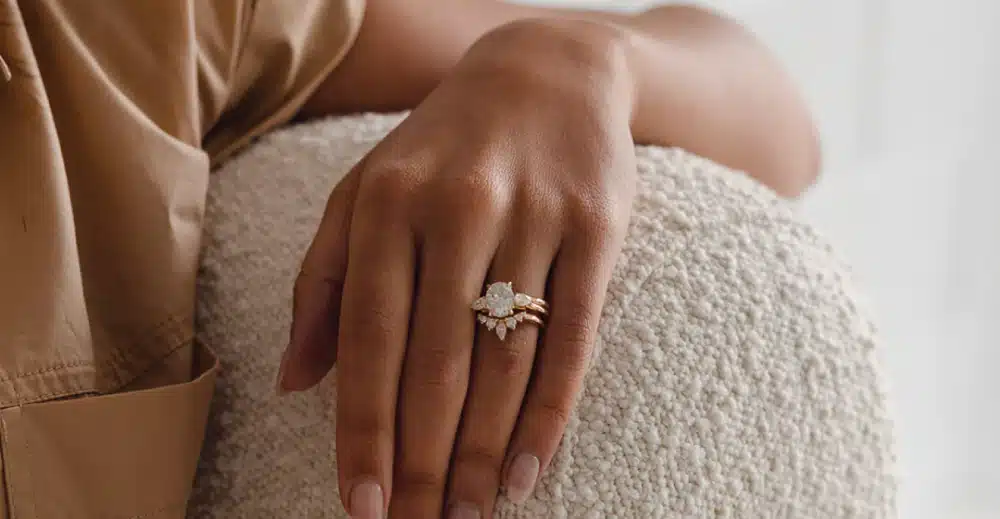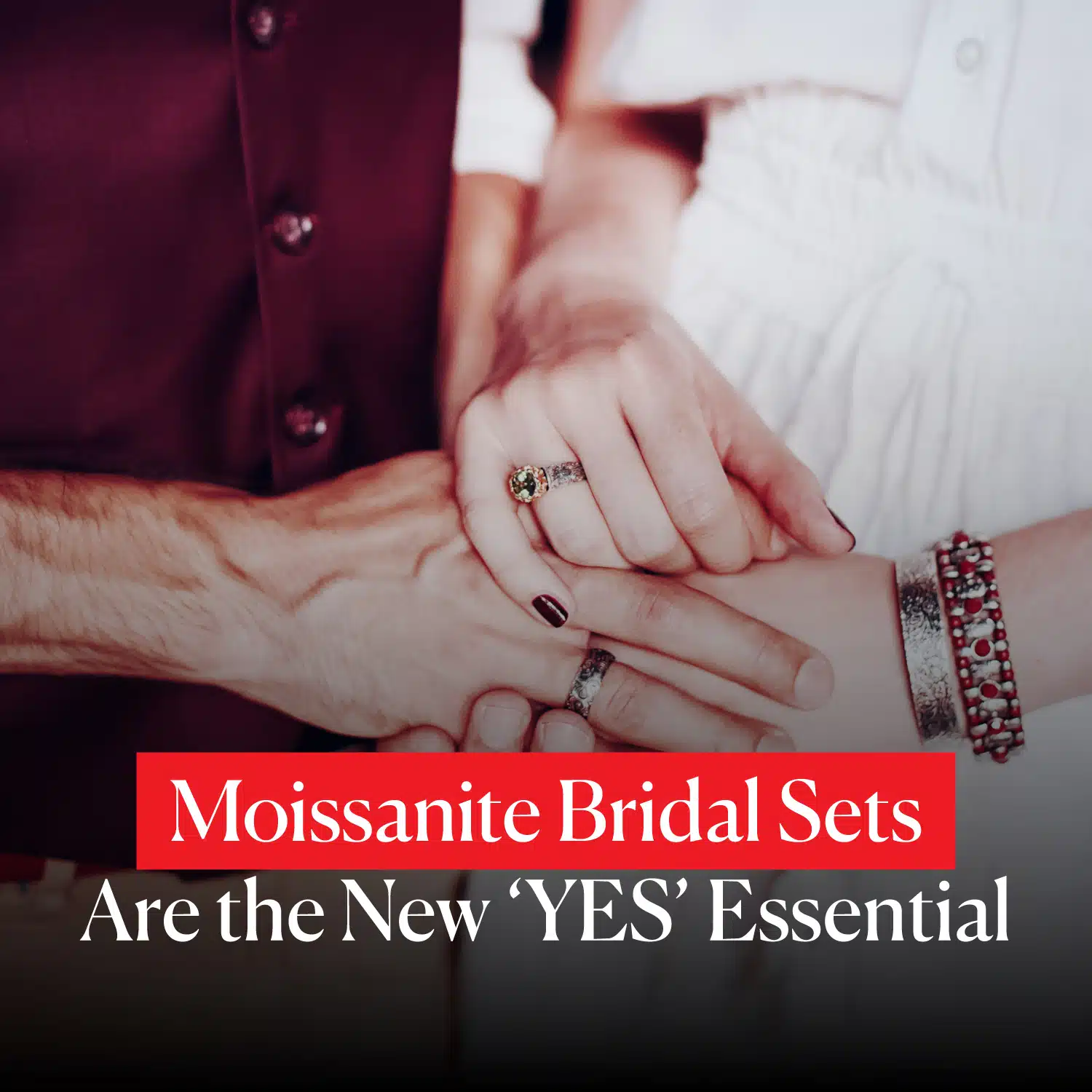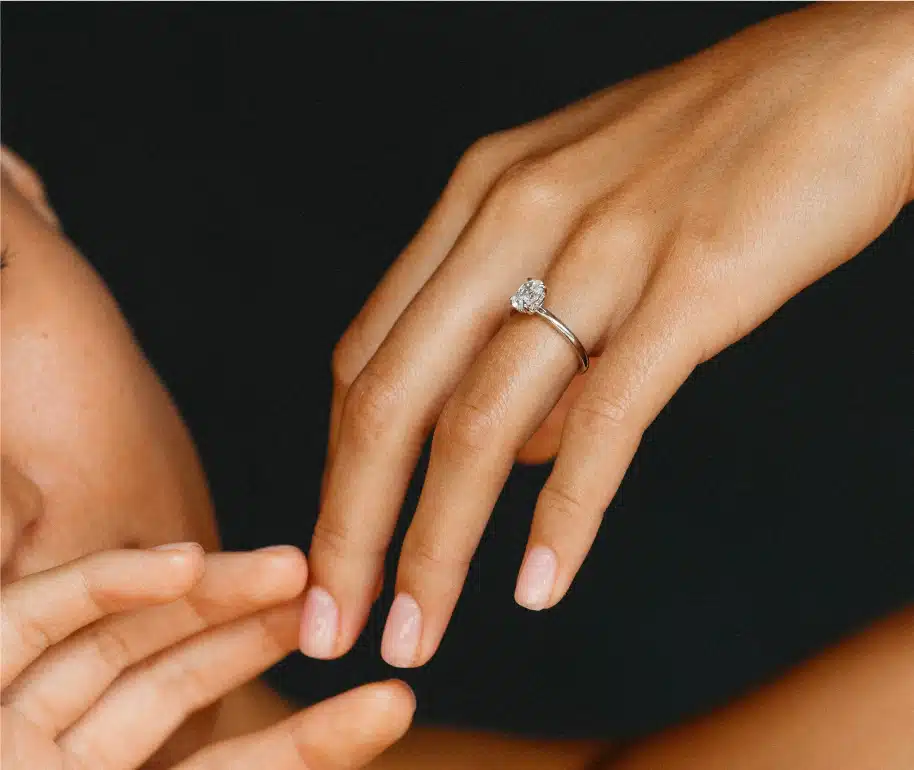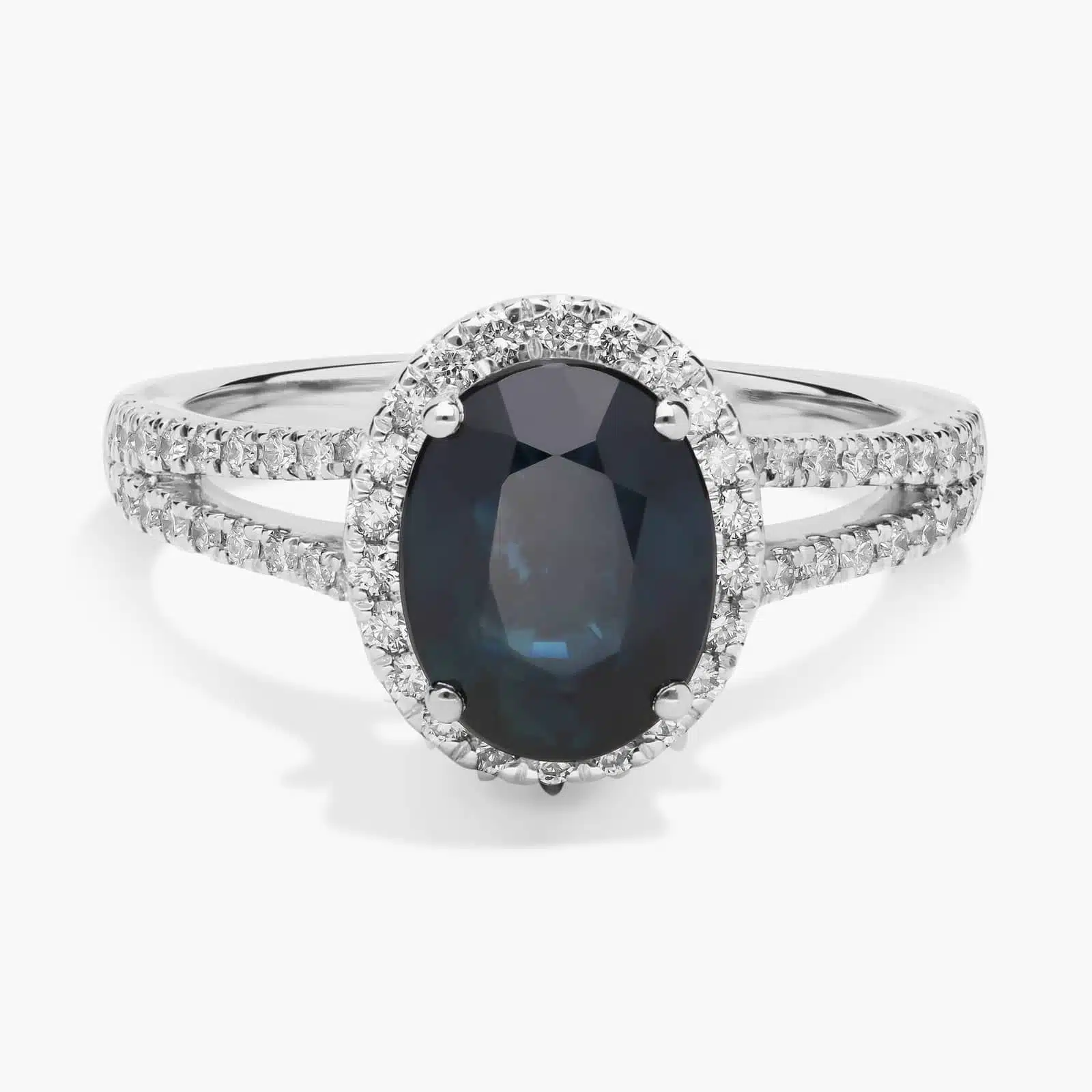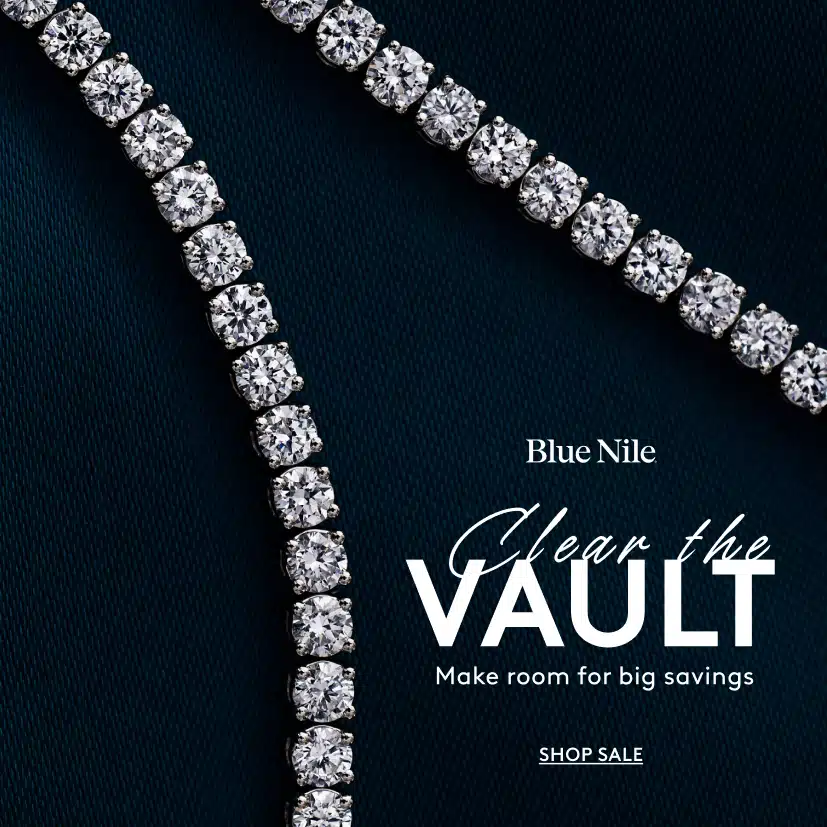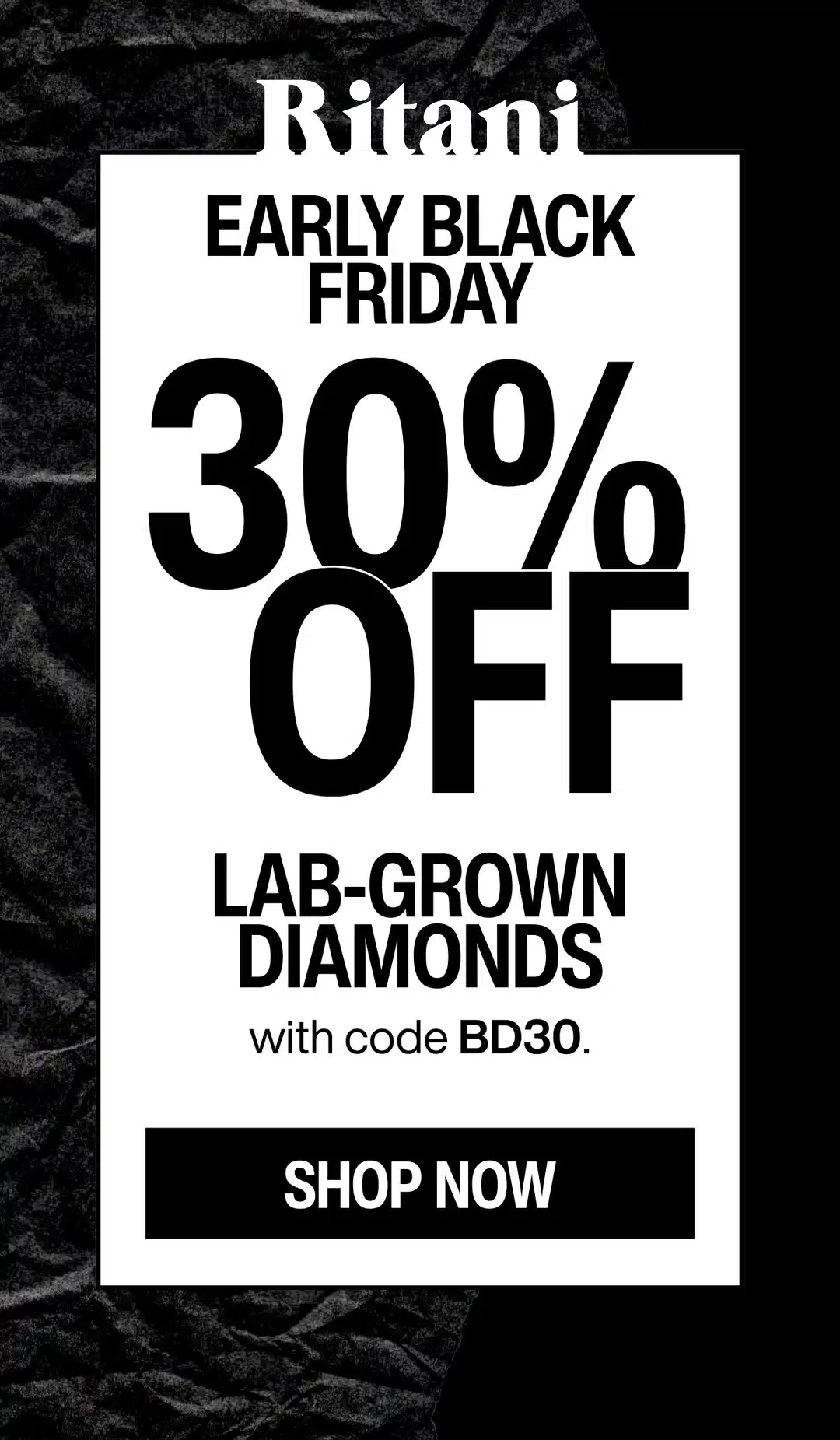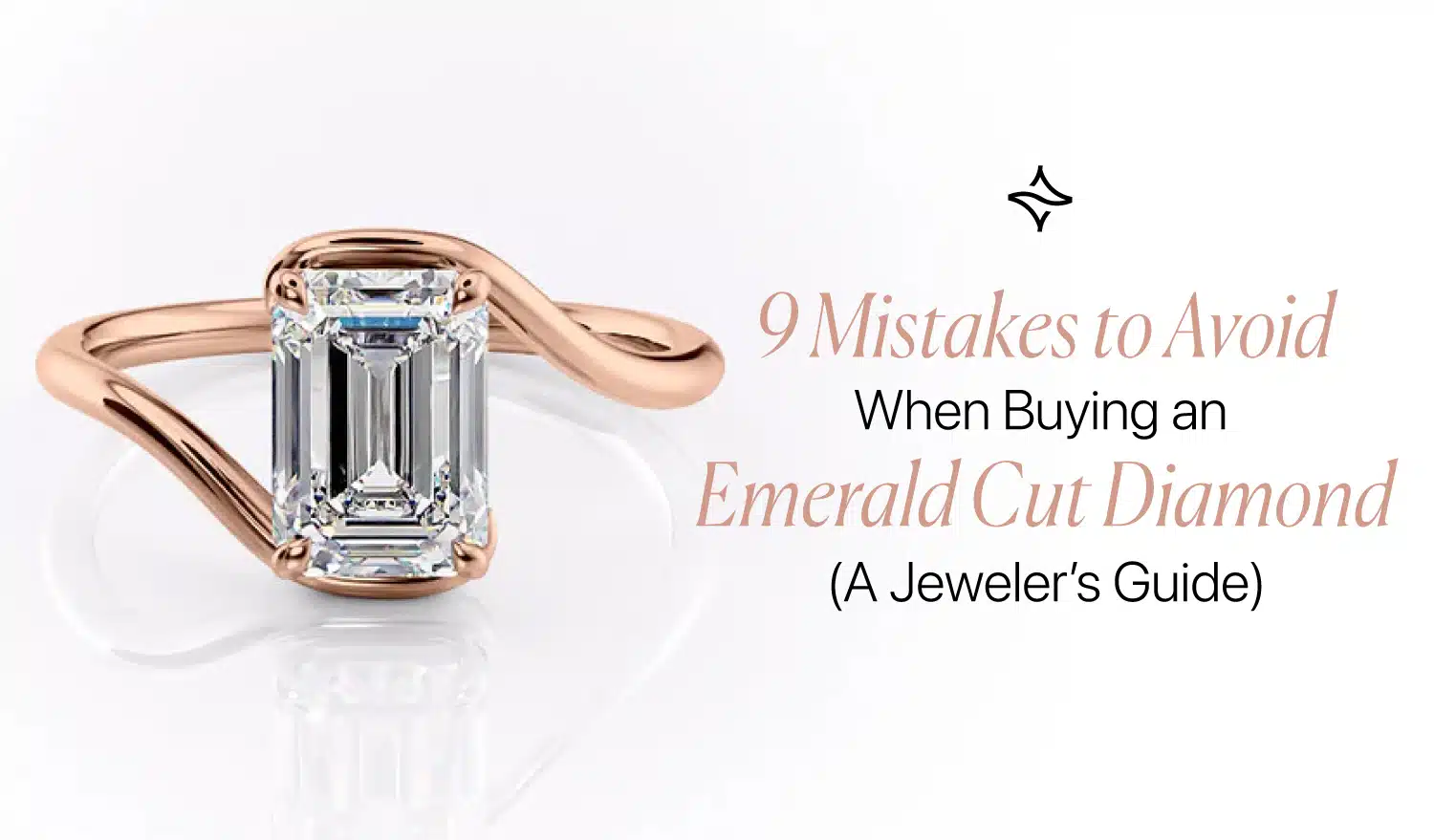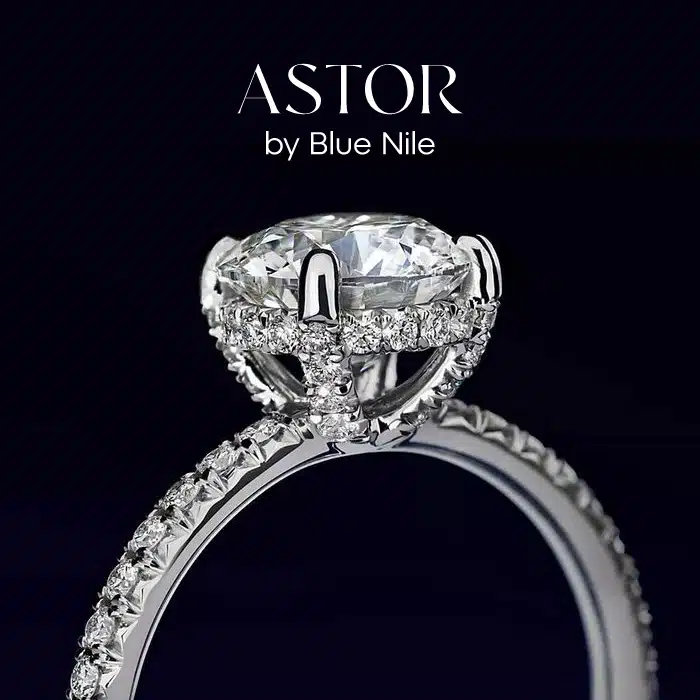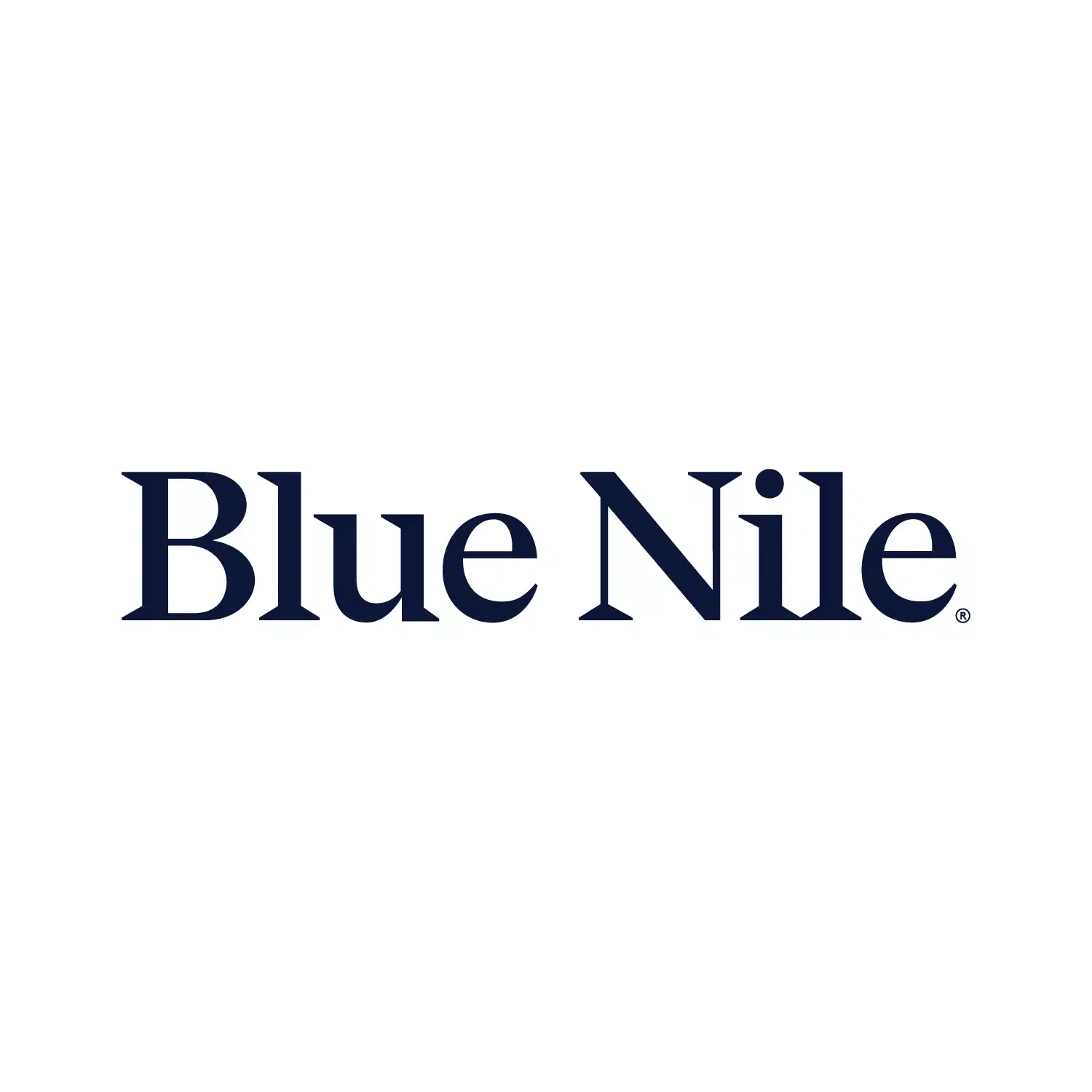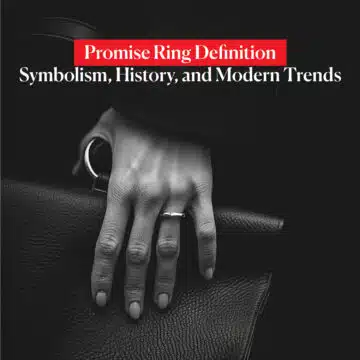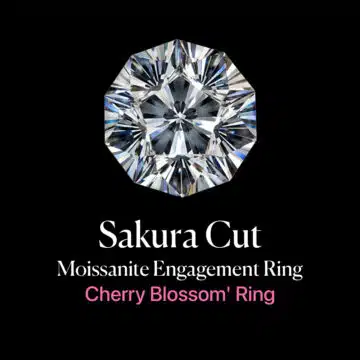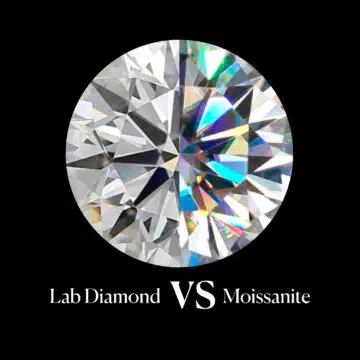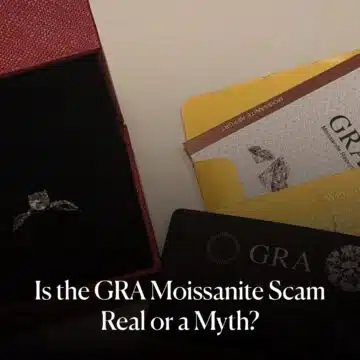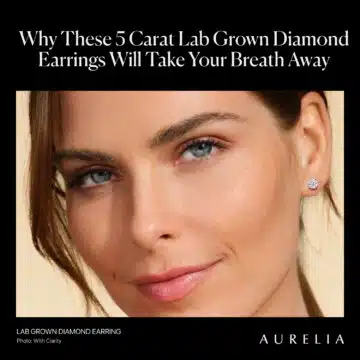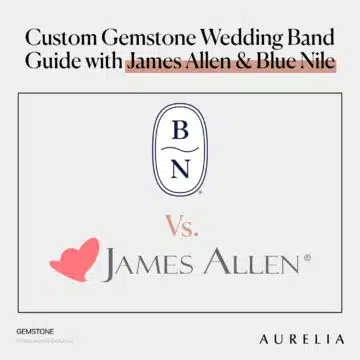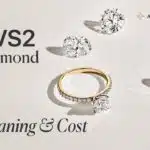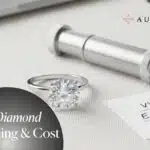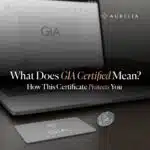The nine biggest mistakes to avoid when buying an emerald cut diamond are: choosing a low clarity grade that reveals visible flaws, expecting a fiery “sparkle” instead of its classic “hall-of-mirrors” flash, ignoring crucial cut factors like proportions and symmetry, selecting a color grade that’s too low, choosing the wrong length-to-width ratio for your taste, picking a “dead” stone with poor light performance, selecting an unflattering setting, forgetting to check for a bowtie effect in very elongated stones, and relying solely on a certificate that lacks an overall cut grade.
You’ve been captivated by the emerald cut’s cool, Art Deco elegance. It’s a choice that signifies confidence and timeless style.
But unlike brilliant cuts that hide flaws in a fiery sparkle, the emerald cut’s deep, clear window reveals everything. This complete transparency is both its greatest beauty and its biggest risk. One small mistake can’t be hidden.
As your friend in the business, I’m here to ensure you don’t make those mistakes. We are going to walk through the 9 most common traps that buyers fall into with emerald cuts.
For each trap, I’ll give you a simple, powerful solution. By the end, you’ll be able to choose an emerald cut with the critical eye of an expert.
- A Shape for the Confident & Classic
- My Expert Guide to Choosing the Perfect Emerald Cut (Avoid These 9 Mistakes)
- How Much Does an Emerald Cut Diamond Cost? (And Why Is It a Good Value?)
- A Visual Guide to Emerald Cut Sizes
- How Does the Emerald Compare to the Asscher, Cushion, Radiant, and Round?
- Your Emerald Cut Diamond Questions, Answered
- The Verdict: A Cut for the Confident Connoisseur
Diamond IQ Test: Natural or Lab-Grown?
Two identical diamonds: GIA Certified, 1.51ct, D Color, VVS1, Ideal Cut. One is natural ($16,530), the other is lab-grown ($2,390). Choose the diamond you like better and see if you can match it to its origin.
A Shape for the Confident & Classic
Before we dive into the mistakes you need to avoid, let’s take a moment to appreciate why you were drawn to the emerald cut in the first place. This isn’t just a diamond shape; it’s a statement. Its soul was forged in the bold, geometric rebellion of the Art Deco era of the 1920s.
Think of the clean lines of a skyscraper, the glamour of a classic film star, the quiet confidence of “old money” elegance. That is the vibe of an emerald cut. It’s a choice that doesn’t scream for attention with fiery sparkle, but instead captivates with its cool, serene, and architectural beauty.
Now, as much as I admire this sophisticated cut, my job is to be your honest friend in the business. The very things that make the emerald cut so unique are also what make it so demanding. Let’s lay it all out with a clear-eyed look at its pros and cons.
| The Pros of an Emerald Cut | The Cons of an Emerald Cut |
|---|---|
| Understated, Elegant “Hall-of-Mirrors” Effect | Shows Inclusions Easily (Clarity is Key) |
| Appears Larger Than Other Shapes (Good “Spread”) | Does Not Hide Color Well |
| Excellent Value (15-25% Cheaper Than Rounds) | GIA Does Not Assign an Overall Cut Grade |
| Unique and Distinctive Style | Not as Fiery or “Sparkly” as Brilliant Cuts |
So what does this all mean for you, the buyer? It means you’ve chosen a shape that offers incredible style and fantastic value.
But look closely at that “Cons” column—each one of those points is a potential trap. The very transparency that makes an emerald cut so beautiful is also what makes it unforgiving. It’s a shape that doesn’t hide its secrets, which is precisely why it’s for an informed buyer.
These challenges aren’t deal-breakers; they are simply the reasons you need a clear blueprint to follow. For a full overview of how the emerald cut compares visually to its peers, our Diamond Shapes Guide provides a fantastic lineup. Now, let’s make sure you avoid the mistakes that so many others make with this stunning diamond.
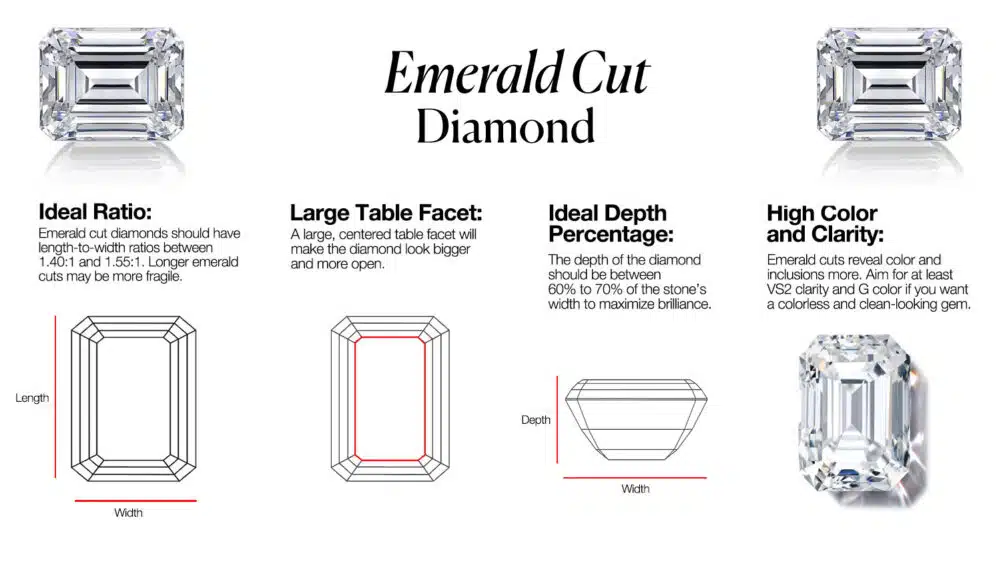
My Expert Guide to Choosing the Perfect Emerald Cut (Avoid These 9 Mistakes)
Welcome to the most important part of this guide. We are now going to walk through the nine most common—and costly—mistakes I see people make when buying a beautiful emerald cut diamond.
I’m going to break down each trap, show you exactly why it’s a problem, and give you a simple, powerful solution to avoid it. Master these nine points, and you will navigate your search with the confidence and critical eye of a seasoned professional.
Mistake #1: Expecting a “Sparkly” Diamond (and Misunderstanding its Unique Beauty)
The Trap: This is the most common and fundamental mistake. Buyers who are used to the fiery, splintery sparkle of brilliant cuts (like the round or cushion) look at an emerald cut and think something is wrong.
They expect that familiar “sparkle,” and when they don’t see it, they dismiss a potentially beautiful stone as being dull or low quality.
The Harsh Reality: An emerald cut is not designed to “sparkle” in the traditional sense. It’s designed to flash. Its beauty is completely different. If you buy an emerald cut expecting the fire of a round brilliant, you will always be disappointed.
The Mehedi Solution: Embrace the “Hall-of-Mirrors” Effect
You must adjust your expectation from “sparkle” to “elegance.” An emerald cut is a step cut, which means it has long, linear, rectangular facets that run parallel along the length of the stone. Think of them as a perfectly aligned staircase leading down into the heart of the diamond.
When you look at a well-cut emerald diamond, you are not meant to see a glittery explosion. Instead, you should see a breathtaking “hall-of-mirrors” effect.
As you rock the diamond back and forth, you’ll see broad, dramatic flashes of white light (called “flash” or “glare”) and deep, clear panes of darkness, creating a stunning on/off pattern. It’s a cool, architectural, and deeply mesmerizing effect.
- Brilliant Cut: Like a glittering, sunlit ocean surface. Chaotic, fiery, and full of energy.
- Emerald Cut (Step Cut): Like a perfectly still, clear lake reflecting the sky. Calm, elegant, and deep.
The beauty of an emerald cut lies in its clarity and its clean, confident flashes of light. It’s a statement of sophistication, not a shout for attention.
If you love that icy, geometric elegance, then you’ve found your perfect diamond. If you truly crave that fiery sparkle, a brilliant cut is a better choice for you.
Mistake #2: Going Too Low on Clarity (The Unforgiving Window)
The Trap: A buyer has learned the smart-money rule for brilliant cuts: find an eye-clean SI1 or even SI2 diamond and save a fortune. They then try to apply this exact same rule to their emerald cut diamond search.
The Harsh Reality: This is the single most expensive mistake you can make. The emerald cut’s large, open table (its main top facet) is a crystal-clear, unobstructed window straight into the very center of the stone.
Unlike a brilliant cut, it has no complex facet pattern to break up light and camouflage small imperfections. An inclusion that would be completely invisible in a round brilliant can look like a glaring flaw right in the middle of an emerald cut’s window.
The Mehedi Solution: Make Clarity Your #1 Technical Priority and Aim for VS2 or Higher
When buying an emerald cut, clarity is not the place to hunt for a bargain. Here is my breakdown of the GIA clarity grades and how you should apply them specifically to an emerald cut search:
| Clarity Grade | My Expert Recommendation for an Emerald Cut |
| I1, SI2 | Almost Never Eye-Clean. Avoid these grades entirely unless you can physically inspect the stone and the inclusion is a minor feather right on the edge, far from the central window. This is extremely rare. |
| SI1 | The Risky Bargain. It is possible to find an eye-clean SI1, but it’s very difficult. The inclusion must be small, not dark in color, and located off to the side or under a corner facet. You MUST rely on high-quality 360° videos to verify. This is an expert-level hunt. |
| VS2 | The Absolute Minimum Safe Bet. This is my baseline recommendation. In most cases, VS2 inclusions are not visible to the naked eye. It offers a fantastic balance of a clean appearance and a good price. It’s the sweet spot for the savvy buyer. |
| VS1 | The Worry-Free Zone. At this grade, the inclusions are very minor and almost always completely invisible to the naked eye. If you have a slightly higher budget and want extra peace of mind, a VS1 is an excellent choice. |
| VVS2+ | The Collector’s Grade. The inclusions are so small they are difficult for a gemologist to find under 10x magnification. While stunning, you are paying a significant premium for a level of flawlessness that has no additional visual benefit. |
But it’s not just the grade that matters; it’s the type of inclusion. Here’s a quick guide to what to watch out for on an emerald cut GIA report plot:
- Avoid: Large, dark crystals or black carbon spots, especially under the table.
- Acceptable: Small, white “feathers” or transparent “clouds” located near the girdle (the edge) or at the corners, as they can be hidden by prongs.
For a deeper dive into these nuances, our comprehensive guide on what is the best diamond clarity provides a fantastic foundation. But for emeralds, the rule is simple: when in doubt, go one grade higher than you would for a round brilliant.
Mistake #3: Ignoring the Length-to-Width Ratio (And Choosing the Wrong Shape)
The Trap: The buyer assumes all emerald cuts are the same classic, rectangular shape they see in movies. They find a diamond with great specs and a good price, but when the ring arrives, the diamond looks oddly square and “stubby” on their finger, not elegant and elongated.
The Harsh Reality: The “shape” of an emerald cut is one of its most defining features, and it can vary dramatically. This is not something to be overlooked. Choosing a shape that doesn’t fit your personal taste or hand can lead to major disappointment.
The Mehedi Solution: Decide on Your Preferred Shape Before You Search
The diamond’s silhouette is defined by its Length-to-Width (L/W) Ratio. You find this number by dividing the diamond’s length by its width (e.g., a 7mm by 5mm diamond has a 1.40 L/W ratio). Here’s a breakdown of the styles you’ll find:
| Length/Width Ratio | Style Description | Mehedi’s Expert Take |
| 1.30 – 1.39 | The Wider Rectangle | A beautifully balanced shape that feels substantial and classic. It has a slightly more “robust” presence than the classic rectangle. |
| 1.40 – 1.50 | The “Classic” Rectangle | This is the iconic emerald cut shape you most often see. It’s the perfect balance of length and width and offers a very graceful, finger-slimming effect. It’s the most sought-after and popular range. |
| 1.51 – 1.60 | The Elongated Rectangle | A long, slender, and dramatic shape that provides maximum finger coverage. It has a very modern and fashion-forward look. |
| Below 1.30 | The “Almost Square” | These stones can look a bit wide and less elegant. If you prefer a square shape with step cuts, you should consider the Asscher cut instead. |
There is no “best” ratio; it is purely a matter of personal style. My advice is to look at real-world examples and decide if you are drawn to the classic, the wider, or the more elongated look.
Then, when you begin your search on a site like James Allen or Blue Nile, you must use the L/W ratio filter to ensure you are only seeing diamonds with the exact shape you desire.
Mistake #4: Trusting the Certificate for Cut Quality
The Trap: A buyer sees “GIA Certified” and assumes all the quality metrics have been graded. They look for a “Cut” grade on the report for their emerald cut and, seeing none, either panic or assume it doesn’t matter.
The Harsh Reality: The GIA does NOT provide an overall Cut grade for any fancy-shaped diamond, including the emerald cut.
The certificate will give you detailed specs, but it will not give you a simple “Excellent,” “Very Good,” or “Good” summary of how those specs work together. This means you have to be the judge.
The Mehedi Solution: Use Expert Proportions as Your Starting Point, Not Your Finish Line
While there is no single “perfect” set of numbers, there are certainly proportions that are known to produce a beautiful, lively emerald cut. Use the following table as your initial filtering guide to weed out the poorly cut stones:
| Cut Quality Recommendations | Excellent | Very Good | Good |
| Table % | 61-69% | 57-60% or 70-72% | 54-56% or 73-74% |
| Depth % | 61-67% | 59-60.9% or 67.1-70% | 57-58.9% or 70.1-74% |
How to Use This Table:
- Depth Percentage: This is crucial. Too shallow (under 61%), and the stone will look glassy and transparent, with no life. Too deep (over 74%), and the light will get trapped at the bottom, creating a dark, dead-looking center. Your goal is that sweet spot from 61-67%.
- Table Percentage: This is the large main facet. You want a table that is in proportion to the rest of the stone to allow light to enter and exit properly. The 61-69% range is ideal.
These numbers are a fantastic tool for your initial search filter, but they are not a substitute for your own eyes. A stone can have “perfect” numbers and still lack that magical flash.
A full understanding of these principles is covered in our Diamond Cut Chart, but the key takeaway for emerald cuts is that the certificate gets you in the ballpark, but the video tells you who won the game.
Mistake #5: Forgetting About Symmetry & Polish
The Trap: This is a huge, high-value gap the competitors miss, and a trap many buyers fall into. A buyer finds a diamond with a great price, a VS2 clarity, and good table/depth numbers, but they don’t look any deeper at the other grades on the certificate.
The Harsh Reality: In a brilliant cut, the chaotic sparkle can hide tiny flaws in symmetry or polish. In an emerald cut, with its long, clean, unforgiving lines, even the slightest flaw in symmetry or polish is glaringly obvious.
Poor symmetry means the “steps” in your hall of mirrors will look wobbly and uneven, destroying the entire effect. Poor polish means the surface of those “mirrors” is slightly scuffed, dulling their reflective power.
Read Our 5-Star Blue Nile Review
Check our comprehensive Blue Nile review to learn why we rated Blue Nile 5 stars for their exceptional quality and value.
The Mehedi Solution: Insist on “Excellent” for Both Polish and Symmetry
This is one of the easiest and most important rules. When you are setting your filters, you MUST set both Polish and Symmetry to “Excellent.” Period. Non-negotiable.
The price difference between a stone with “Very Good” polish/symmetry and one with “Excellent” is almost negligible, but the visual difference in the final stone can be enormous.
An emerald cut with perfect, crisp, and aligned facets will have a much more dramatic and beautiful flash. Don’t compromise here.
Mistake #6: Choosing a Low Color Grade
The Trap: A buyer is trying to maximize their carat size and decides to save a significant amount of money by choosing a K or J color emerald cut. They’ve heard that H is a great value, so how much different can J be?
The Harsh Reality: A lot different, especially in an emerald cut. Just like clarity, the long facets and deep, open window of an emerald cut tend to retain and reveal color much more than a brilliant cut does.
That faint warmth in a J-color diamond that might be unnoticeable in a round brilliant can present as a clear and often undesirable yellow tint in the body of an emerald cut.
James Allen: Our 5-Star Choice for Price and Selection
Check our comprehensive James Allen Review to learn more about their pricing and commitment.
The Mehedi Solution: Stick to the “Sweet Spot” Grades Based on Your Setting Metal
| Your Metal Choice | My Color Grade Recommendation | The “Why” |
| White Gold or Platinum | G or H Color | An H color will look bright and white against the cool tones of the metal. This is my top value recommendation. A G color will be even icier. I would not go below an H in a white setting. |
| Yellow Gold or Rose Gold | I or J Color | A savvy choice! The warmth of the metal will perfectly complement the subtle warmth in an I or J color diamond, making it face up white in contrast and saving you a significant amount of money. |
An E Color Diamond or D color is a beautiful but unnecessary luxury for most buyers. By staying in that G-H range for white gold, you are making the absolute smartest financial decision.
Lifetime Protection Alert!
A James Allen purchase includes a free lifetime warranty. This covers free prong tightening, polishing, and cleaning for life, ensuring your jewelry always looks its best.
Mistake #7: Picking a “Dead” Stone (Even with a Good Certificate)
The Trap: The buyer does everything right. They find a stone with an “Excellent” polish/symmetry, VS1 clarity, G color, and perfect on-paper proportions. They buy it without looking at the video because the certificate is flawless.
The Harsh Reality: The ring arrives, and the diamond just looks… flat. It has no life, no pop. Even a technically perfect emerald cut can have a lack of “light performance” if the precise combination of angles isn’t quite right.
The Mehedi Solution: The Video is Your Final and Most Important Test
The certificate is for verification. The 360° video is for beauty. You MUST watch the video of your final contenders and look for the following:
- The “On/Off” Flash: As the diamond rotates, do you see those broad, dramatic flashes of bright light turning on and off? A great emerald cut will have a dynamic, lively flash.
- Minimal “Dark Zones”: Every emerald cut will have dark areas, that’s part of the contrast that makes it beautiful. But the stone should not look overwhelmingly dark or have a large “dead” spot in the middle.
- Brilliance Across the Steps: The light should seem to dance up and down the “staircase” of the facets.
Some premium branded cuts, like those explored in our Astor by Blue Nile Cut review, are specifically pre-vetted for this exact kind of optimal light performance, but you can absolutely find it on your own if you trust your eyes and the video.
Astor by Blue Nile is the collection for the data-driven buyer who demands scientific proof of performance. These diamonds are selected from the top 0.1% of Blue Nile's massive inventory, representing the most elite stones they offer. The collection's foundation is a unique dual-certification system that removes all guesswork, providing objective, third-party validation of a diamond's sparkle.
WHAT WE LOVE ABOUT THIS COLLECTION:
- Exclusive Dual Certification: Every diamond includes a GIA report plus a GemEx Light Performance report.
- Scientific Brilliance Scores: The GemEx report provides objective, numerical scores for Brilliance, Fire, and Sparkle.
- Ultimate Curation: Represents the absolute pinnacle of Blue Nile's inventory—only one in a thousand diamonds makes the cut.
- Guaranteed Performance: The strict vetting process guarantees an elite level of light performance, backed by data.
- The "Peace of Mind" Purchase: Perfect for buyers who want the proven best without needing to become a gemology expert themselves.
- Backed by Blue Nile's Upgrade Program: Your Astor diamond's full value can be applied toward a future upgrade.
Mistake #8: Ignoring the Setting’s Influence
The Trap: The buyer is so focused on the diamond that they spend only five minutes choosing a setting, picking one that is bulky or overly trendy.
The Harsh Reality: The setting can either elevate your emerald cut or completely ruin its elegant aesthetic. The clean, geometric lines of the emerald are its superpower, and a clumsy or overpowering setting can completely overwhelm it.
The Mehedi Solution: Choose a Setting that Complements, Not Competes
- Ideal Choices:
- Solitaire Setting: A simple four-prong solitaire is the quintessential choice. It is clean, timeless, and allows the unique shape of the emerald to be the undisputed star of the show.
- Three-Stone Setting: This is another iconic look. Flanking a central emerald with two smaller side stones (either smaller emeralds, tapered baguettes, or even trapezoids) creates a beautiful, architectural, and balanced ring.
- Solitaire Setting: A simple four-prong solitaire is the quintessential choice. It is clean, timeless, and allows the unique shape of the emerald to be the undisputed star of the show.
- What to be Careful With:
- Thick Bezel Settings: While secure, a very thick bezel can hide the cropped corners and make the emerald look more like a plain rectangle.
- Overly Ornate Halos: A very busy or floral halo can sometimes clash with the clean, modern lines of the emerald cut. A simple, delicate halo is usually a better choice.
- Thick Bezel Settings: While secure, a very thick bezel can hide the cropped corners and make the emerald look more like a plain rectangle.
Ultimately, this is where you can see the magic happen. I always recommend using a tool like the one found when you build your own engagement ring on James Allen to virtually pair your chosen diamond with different settings to see what you love best.
James Allen is a top leader in online diamond sales, offering cutting-edge imaging technology that lets you inspect diamonds as if you were using a jeweler's loupe. With the largest exclusive selection of loose diamonds available online and excellent pricing, they also boast one of the finest collections of lab-created diamonds on the market. They currently run a 25% discount on selected lab-grown diamonds!
WHAT WE LOVE ABOUT THEM:
- 30-day no-questions-asked return policy, with a prepaid shipping label provided by James Allen.
- Lifetime warranty on all purchases.
- Free international shipping.
- Complimentary prong tightening, repolishing, rhodium plating, and cleaning every six months.
- Insurance appraisals included with purchases.
- One free resizing within 60 days of purchase.
- Free ring inscriptions available.
- Best-in-class high-quality imagery for every diamond in stock.
- 24/7 customer support.
- Premium, best-in-class packaging.
Mistake #9: Choosing the Wrong Diamond “Type” for a Fancy Color
The Trap: This is a more advanced mistake, but an important one for a true connoisseur. A buyer looking for a fancy colored diamond (like a yellow or a pink) treats all diamonds as if they are the same chemically.
The Harsh Reality: The chemical makeup of a diamond can dramatically affect the purity and intensity of its color, which is a huge driver of value.
The Mehedi Solution: Understand the “Collector’s Grade” – Type IIa Diamonds
For 98% of buyers choosing a white diamond, this is not something you need to worry about. But for those looking for a truly exceptional fancy colored diamond, or the purest D-color stones, understanding diamond “types” is key.
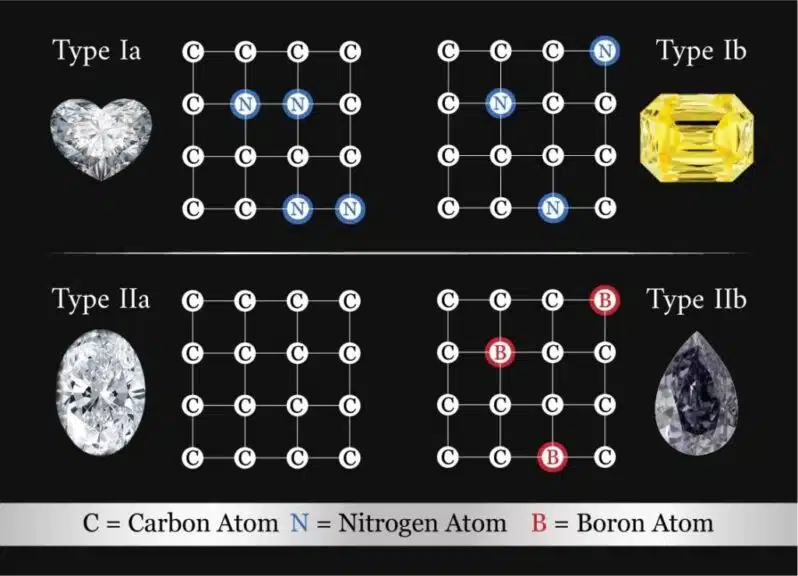
- Type Ia Diamonds: This is your standard diamond. It contains trace amounts of nitrogen, which can sometimes impart a very faint yellowish hue. 98% of all diamonds fall into this category.
- Type IIa Diamonds: These are the superstars of the diamond world. Making up less than 2% of all mined diamonds, they are chemically pure, containing no measurable nitrogen. This purity allows them to achieve a perfect, water-clear D color.
More importantly for fancy colors, this lack of nitrogen means that their color (often pink or brown) comes from distortions in their crystal structure, not chemical impurities. This results in an incredibly pure and saturated hue.
The emerald cut is the perfect shape for showcasing these rare Type IIa colored diamonds. Its broad facets and deep window don’t break up the light into distracting sparkle, but instead allow you to look deep into the stone and appreciate the rich, pure, uninterrupted color.
While it is not an everyday purchase, understanding this distinction proves you know your gems, right down to the level of their origin, a concept that is also at the heart of our article on why we refer to some diamonds as conflict materials.
How Much Does an Emerald Cut Diamond Cost? (And Why Is It a Good Value?)
Alright, let’s talk about the bottom line: your budget. The sophisticated elegance of the emerald cut diamond can make it feel like it should be the most expensive diamond shape, but here is one of its most wonderful secrets: it offers some of the best value available.
As we’ve discussed, a diamond’s price is heavily influenced by how much of the original rough diamond crystal is lost during the cutting and polishing process. A round brilliant can lose over 50% of the original stone.
The emerald cut, with its rectangular shape, is much more efficient. It conforms more closely to the natural shape of many diamond crystals, meaning the cutter can preserve more of the carat weight.
This higher “yield from rough” means less waste, and that cost savings is passed directly on to you. On average, you can expect an emerald cut to cost 15-25% less than a round brilliant of the exact same carat weight and quality.
This is a massive advantage that allows you to either get a significantly larger stone for your budget or save a considerable amount of money.
To give you a real-world starting point, here is a sample pricing table for a high-quality natural emerald cut diamond (using our recommended “sweet spot” specs of H color and VS2 clarity). Please remember that prices fluctuate, but this is a very realistic guide for what you can expect.
| Carat Weight | Typical Price Range (H Color, VS2 Clarity) |
| 1.00 Carat | $3,300 – $4,500 |
| 1.50 Carat | $7,000 – $9,500 |
| 2.00 Carat | $14,000 – $18,000 |
What this table shows is the incredible value at every level. The two-carat mark is a hugely popular milestone for emerald cuts, as the shape really starts to show off its elegant proportions at this size.
For anyone seriously considering a stone this impressive, it’s worth doing a deep dive into the specific offerings from the top online retailers. We do a full head-to-head analysis in our guide to 2 Carat Emerald Cut Rings: Blue Nile vs. James Allen.
And if you’re aiming for a true showstopper, the value continues. As you can see, diamond prices scale exponentially—the price-per-carat increases as the stones get larger and rarer. When you reach the three-carat mark, the differences in cut quality and vendor pricing become even more critical.
We’ve created a dedicated guide to help you navigate this high-value purchase: 3 Carat Emerald Cut Ring: James Allen vs. Blue Nile.
A Visual Guide to Emerald Cut Sizes
This is where the emerald cut truly becomes a superstar for a savvy buyer like you. Before we look at the charts, you must remember this critical rule: carat is a measure of WEIGHT, not of visual size. How big a diamond looks on a finger is all about its surface dimensions, what we in the trade call its “spread.”
Because of its elongated shape and typically shallower depth compared to a round brilliant, the emerald cut has a larger table and a greater surface area.
This means that a 1.00-carat emerald cut will look noticeably larger face-up than a 1.00-carat round brilliant. It’s a fantastic optical illusion that gives you a major “wow” factor for your money.
The tables below are your guide to understanding the real-world measurements of emerald cuts at different carat weights. I’ve separated them into the classic Rectangular shape and the less common Square shape.
Rectangular Emerald Cut Diamond Size Chart (Classic Shape)
| Carat Weight | Average Size in MM |
| 0.50 ct. | 6×4 mm. |
| 1.00 ct. | 7×5 mm. |
| 1.50 ct. | 7.5×5.5 mm. |
| 2.00 ct. | 8.5×6.5 mm. |
| 3.00 ct. | 9.3×7.5 mm. |
| 4.00 ct. | 10×8 mm. |
Square Emerald Cut Diamond Size Chart
| Carat Weight | Average Size in MM |
| 0.50 ct. | 5.0 mm. |
| 1.00 ct. | 6.5 mm. |
| 1.50 ct. | 7.3 mm. |
| 2.00 ct. | 8 mm. |
| 3.00 ct. | 9.1 mm. |
| 4.00 ct. | 10.25 mm. |
Look at the 1.00-carat mark. The square emerald is 6.5mm across. The rectangular emerald is 7mm long by 5mm wide. That extra half-millimeter in length on the rectangular shape makes a huge visual difference on the finger, adding to that flattering, elongated look.
To see how these dimensions compare to all the other diamond shapes, you should definitely have our complete Diamond Carat Size Chart open in another tab. It’s an indispensable tool for visualizing the real-world impact of your choice.
Blue Nile is one of the biggest and most recognized online jewelry retailers, offering an extensive and exclusive inventory. Their high-resolution images are improving and getting closer to the quality offered by James Allen, while their prices remain highly competitive. Right now, Blue Nile offers up to 30% savings on jewelry during a limited-time sale.
WHAT WE LOVE ABOUT THEM:
- 30-day no-questions-asked return policy, with a prepaid shipping label provided by Blue Nile.
- Lifetime warranty on all purchases.
- Free shipping on every order.
- Complimentary services every six months, including prong tightening, repolishing, rhodium plating, and cleaning.
- Insurance appraisal included with your purchase.
- One free resizing within the first year.
- High-quality images available for roughly half of their diamond selection.
- 24/7 customer service support.
- Full credit toward future upgrades, as long as the new item is at least double the value.
- Best-in-class order fulfillment process.
How Does the Emerald Compare to the Asscher, Cushion, Radiant, and Round?
Choosing a diamond shape is deeply personal. If you love the elegant look of an emerald cut but are still a little undecided, this is the section for you.
We’re going to put the emerald head-to-head with its top four competitors: its step-cut sibling (the Asscher), its rectangular rival (the Radiant), its romantic alternative (the Cushion), and the classic champion (the Round).
For a complete overview of all your options, our Diamond Shapes Guide is a fantastic starting point.
Emerald Cut vs. Asscher Cut
This is a battle of siblings. Both are “step cuts,” meaning they are built for clarity and flashes of light, not fiery sparkle. The only real difference is their geometry.
| Feature | Emerald Cut | Asscher Cut |
| Look & Feel | Elegant Rectangle | Art Deco Square |
| Sparkle Style | Hall-of-Mirrors | Hall-of-Mirrors (with a distinct “X”) |
| Clarity Needs | Very High (VS2+) | Very High (VS2+) |
| Price | Excellent Value | Excellent Value |
My Mehedi Take: Your choice here is purely about style preference. If you love the classic, finger-slimming effect of a rectangular stone, the Emerald is your perfect match.
If you are a true Art Deco purist who loves the mesmerizing, geometric depth and mesmerizing “windmill” pattern of a perfect square, the Asscher is an unbeatable choice.
Emerald Cut vs. Radiant Cut
This is the ultimate showdown of “shape vs. sparkle.” Both are typically rectangular, but their personalities couldn’t be more different.
| Feature | Emerald Cut | Radiant Cut |
| Look & Feel | Elegant & Understated | Energetic & Fiery |
| Sparkle Style | Bright, Clean Flashes | “Crushed-Ice” Scintillation |
| Clarity Needs | Very High (VS2+) | Medium (SI1+) |
| Price | Excellent Value | Excellent Value |
My Mehedi Take: This is a crucial decision point. If you love the rectangular shape but crave a fiery, brilliant sparkle that rivals a round, the Radiant is your diamond. Its brilliant facet pattern also hides inclusions exceptionally well, making it a fantastic value if you’re comfortable finding an eye-clean SI1.
If you are a minimalist who loves the clean lines and cool, architectural flashes of light, the Emerald is the more sophisticated choice.
Emerald Cut vs. Cushion Cut
This is a comparison of two different kinds of vintage romance: the bold, geometric glamour of the Art Deco era vs. the soft, candlelit feel of the Victorian era.
| Feature | Emerald Cut | Cushion Cut |
| Look & Feel | Architectural & Elegant | “Pillow-Like” & Romantic |
| Sparkle Style | Bright, Clean Flashes | “Crushed-Ice” or “Chunky” Fire |
| Clarity Needs | Very High (VS2+) | Medium (SI1+) |
| Price | Excellent Value | Excellent Value |
My Mehedi Take: A Cushion Cut is a brilliant cut trying to be soft and romantic, with rounded corners and a fiery sparkle. An Emerald Cut is a step cut that is unapologetically bold and clean.
The Cushion is more forgiving on clarity and offers a more traditional “sparkly” look, while the Emerald is a statement of confident, understated elegance. Our Cushion Cut Diamond Guide provides a much deeper dive into its unique “personalities.”
Emerald Cut vs. Round Brilliant Cut
This is the ultimate showdown: cool, understated confidence versus fiery, timeless brilliance. It’s the two titans of their respective categories.
| Feature | Emerald Cut | Round Brilliant Cut |
| Look & Feel | Sophisticated & Architectural | Classic & Fiery |
| Sparkle Style | Bright Flashes | The Most Brilliant Possible |
| Clarity Needs | Very High (VS2+) | Medium (SI1+) |
| Price | Excellent Value | Highest Price |
My Mehedi Take: This is the clearest trade-off in the diamond world. With a Round Brilliant Cut Diamond, you pay a significant premium for its unmatched, scientifically perfected brilliance and its classic status.
With an Emerald Cut, you get a much larger-looking and more unique stone for your money, but you must invest a portion of those savings into a higher clarity grade to ensure a flawless appearance.
Your Emerald Cut Diamond Questions, Answered
You’ve got the blueprint, but it’s natural to have more questions. The emerald cut is a sophisticated choice, and a little extra knowledge can make all the difference. Let’s tackle the most common questions people ask, using the direct answers you need to feel confident.
An emerald cut diamond is a rectangular or square-shaped diamond with truncated corners and a specific faceting style called a “step cut.” Instead of the fiery sparkle of brilliant cuts, it has long, parallel facets that create a “hall-of-mirrors” effect, producing elegant flashes of light. It’s renowned for its deep clarity and sophisticated, Art Deco look
The main disadvantage of an emerald cut is that its large, open table acts as an unforgiving window into the center of the stone. This means that inclusions are much more visibl than in a brilliant cut. It also tends to show color more easily. This is why you must prioritize higher clarity and color grades when buying one, a key principle we cover in our main Diamond Buying Guide.
A high-quality, 1-carat natural emerald-cut diamond (in the H-color, VS2-clarity range) will typically cost between $3,300 and $4,500. For a lab-grown emerald of the same excellent quality, the price is significantly lower, usually in the range of $800 to $1,500.
For a high-quality 1.5-carat natural emerald-cut diamond (H color, VS2 clarity), the price will generally be between $7,000 and $9,500.
A lab-grown alternative with the same impressive specifications would cost in the range of $1,400 to $2,500, showcasing its exceptional value at higher carat weights. For an in-depth look at what determines value, our guide on the definition of an appraisal for a diamond ring is a vital read.
No, it is significantly less expensive. An emerald cut diamond is one of the most affordable diamond shapes, typically costing 15-25% less than a round brilliant of the same carat weight. Its rectangular shape is more efficient to cut from the rough diamond crystal, which means less waste and a lower price for you.
For resale value, the Round Brilliant holds its value best because its popularity makes it the most liquid and easiest to sell on the secondary market. However, for purchase value, fancy shapes like the emerald, cushion, and oval provide much more size and visual impact for your money.
To understand this complex market, our article on how much can a diamond be sold for provides crucial insights.
While all diamond cuts can be elegant, the emerald cut is widely considered the classiest and most sophisticated choice. Its clean, architectural lines and understated “hall-of-mirrors” flash are associated with a confident, timeless style, famously worn by icons like Grace Kelly and Amal Clooney.
Choosing an emerald cut signifies a confident, sophisticated, and classic sense of style. It suggests an appreciation for understated elegance, architectural beauty, and vintage glamour. It’s a choice that says you value clarity and form over fiery brilliance.
Yes, but that’s by design. An emerald cut does not have the fiery, scintillating sparkle of a round or cushion cut. It sparkles differently. Its step-cut facets are designed to produce broad, dramatic flashes of white light, like a camera flash, not a glittery shimmer.
A classic 1-carat rectangular emerald cut diamond typically measures about 7mm long by 5mm wide. This elongated shape gives it a larger face-up size than a 1-carat round brilliant (which is about 6.4mm in diameter), a key advantage we break down in our article on what shape diamond looks the largest.
Many of these questions can be confusing because the term “emerald” refers to both the green gemstone and the rectangular diamond cut. An emerald cut diamond is a real diamond (10 on the Mohs hardness scale and extremely durable).
The green gemstone emerald is a different mineral (beryl) that is much softer (7.5-8) and more prone to chipping. They are two entirely different things.
If you mean an emerald cut DIAMOND, the only way to be certain it’s real is with a GIA or AGS certificate. If you mean the green gemstone EMERALD, you would need an appraisal from a certified gemologist who specializes in colored stones.
For more info, our guide on how to tell if a diamond is real is a vital resource for diamond buyers.
Celebrities love emerald cut diamonds because they have a large, impressive look, their clean lines photograph beautifully, and they project an image of timeless elegance and sophistication. The elongated shape is also very flattering on the finger, making it a red-carpet favorite.
The Verdict: A Cut for the Confident Connoisseur
The emerald cut is not a diamond for everyone; it’s a choice for someone who appreciates architectural beauty and understated elegance over fiery brilliance. Its demanding nature is what makes a beautiful one so special.
By avoiding these 9 common mistakes, you’ve equipped yourself with the knowledge of a true insider. You now understand how to evaluate its unique cut, prioritize its clarity, and choose a stone that is not just a diamond, but a statement of timeless style. Choose confidently.
Continue Your Research Journey
You’ve now mastered one of the most sophisticated diamond shapes and have the expert knowledge to choose a truly spectacular one. If you’re ready to take the next step in your buying process, these hand-picked guides will help you dive even deeper.
The In-Depth Retailer Reviews
- Our #1 Recommended Retailer: The Ultimate James Allen Review – (https://moissanitebyaurelia.com/james-allen-review/)
- The Industry Heavyweight: The Complete Blue Nile Review for 2024 – (https://moissanitebyaurelia.com/blue-nile-reviews-2024/)
- Another Head-to-Head Battle: Brilliant Earth vs. James Allen Compared – (https://moissanitebyaurelia.com/brilliant-earth-vs-james-allen/)
- A Broader Look at the Market: The Best Places to Buy Premium Jewelry – (https://moissanitebyaurelia.com/best-places-to-buy-premium-jewelry/)
Advanced Diamond Knowledge & Vendor-Specific Cuts
- Go Deeper on Premium Cuts: Astor vs. True Hearts: A Battle of Premium Cuts – (https://moissanitebyaurelia.com/astor-vs-true-hearts/)
- A Deep-Dive on Blue Nile’s Best: Is the Astor Cut Worth It? – (https://moissanitebyaurelia.com/astor-by-blue-nile-cut-worth-it/)
- A Look at James Allen’s Signature Diamonds: An Unbiased James Allen True Hearts Review – (https://moissanitebyaurelia.com/james-allen-true-hearts-review/)
Advanced Diamond Knowledge
- The Foundation: Our No-Nonsense Diamond Grading Chart (The 4 Cs) – (https://moissanitebyaurelia.com/diamond-grading-chart-4-cs-of-diamonds/)
- Mastering the Sweet Spot: A Full Breakdown of VS1 vs. VS2 Diamond Clarity – (https://moissanitebyaurelia.com/vs1-vs-vs2-diamond/)
- An Expert Guide to Value: H Color Diamond Pricing Tips for Buyers – (https://moissanitebyaurelia.com/h-color-diamond-pricing-tips-for-buyers/)
Practical Guides & Strategies
- See How it Stacks Up: A Guide to the Princess Cut Diamond Ring – (https://moissanitebyaurelia.com/princess-cut-diamond-ring-guide/)
- Considering a Lab Diamond?: A Guide to the Types of Lab-Grown Diamonds – (https://moissanitebyaurelia.com/types-of-lab-grown-diamonds/)
- A Look at a Key Detail: What is a Diamond’s Culet? – (https://moissanitebyaurelia.com/what-is-a-diamonds-culet/)
- A Deep-Dive on Clarity: A Full Breakdown of VS1 vs. VS2 Diamond Clarity – (https://moissanitebyaurelia.com/vs1-vs-vs2-diamond/)
- Understanding Value After the Purchase: The Definition of an Appraisal for a Diamond Ring – (https://moissanitebyaurelia.com/definition-of-appraisal-for-diamond-ring/)


